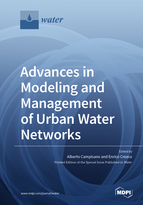Advances in Modeling and Management of Urban Water Networks
A special issue of Water (ISSN 2073-4441). This special issue belongs to the section "Urban Water Management".
Deadline for manuscript submissions: closed (31 July 2020) | Viewed by 61500
Special Issue Editors
Interests: urban water systems; water supply and distribution; urban drainage; sewer systems; rainwater harvesting; real time control; sediment transport
Special Issues, Collections and Topics in MDPI journals
Interests: water distribution modelling; urban drainage modelling; real-time control; sediment transport in sewers; sustainable solutions for urban drainage systems; flood control in urban areas
Special Issues, Collections and Topics in MDPI journals
Special Issue Information
Dear Colleagues,
In recent years, the modelling of urban water networks has experienced a boost for coping with the new challenges coming from modern society. Both water distribution and urban drainage systems are experiencing new trends for improved management. The challenges include, among others, the analysis of the behaviour of water distribution systems under “non-standard” operating conditions, as well as the improvement of network performances through the introduction of smart system solutions. With regard to urban drainage systems, new approaches and methods have been developed to model sustainable solutions for runoff control and peak flow mitigation. The aim of this Special Issue is to provide an overview of the recent trends in hydraulic modelling of urban water networks. Topics will concern new findings and developments in the modelling and management of urban water networks, including intermittent water supply, real time control for pressure and leakage management in water distribution networks, sustainable solutions and green/blue infrastructures for urban drainage systems, flood control, and flood risk assessment especially in urban areas.
Prof. Alberto Campisano
Prof. Enrico Creaco
Guest Editors
Manuscript Submission Information
Manuscripts should be submitted online at www.mdpi.com by registering and logging in to this website. Once you are registered, click here to go to the submission form. Manuscripts can be submitted until the deadline. All submissions that pass pre-check are peer-reviewed. Accepted papers will be published continuously in the journal (as soon as accepted) and will be listed together on the special issue website. Research articles, review articles as well as short communications are invited. For planned papers, a title and short abstract (about 100 words) can be sent to the Editorial Office for announcement on this website.
Submitted manuscripts should not have been published previously, nor be under consideration for publication elsewhere (except conference proceedings papers). All manuscripts are thoroughly refereed through a single-blind peer-review process. A guide for authors and other relevant information for submission of manuscripts is available on the Instructions for Authors page. Water is an international peer-reviewed open access semimonthly journal published by MDPI.
Please visit the Instructions for Authors page before submitting a manuscript. The Article Processing Charge (APC) for publication in this open access journal is 2600 CHF (Swiss Francs). Submitted papers should be well formatted and use good English. Authors may use MDPI's English editing service prior to publication or during author revisions.
Keywords
- Water network modelling
- Numerical models
- Hydraulic software
- Intermittent water distribution systems modelling
- Real-time control
- Smart water networks
- Sustainable urban drainage systems
- Flood control
- Flood risk assessment in urban areas







